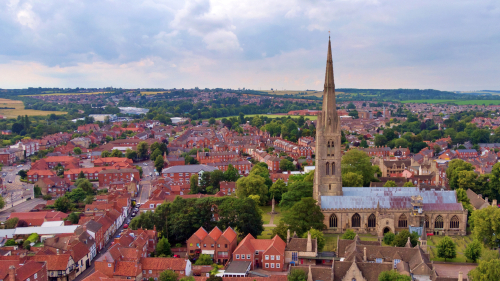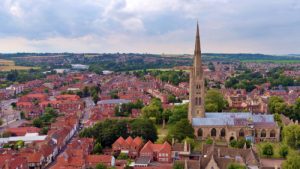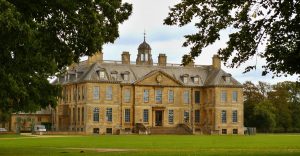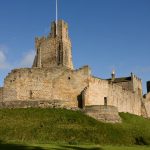
Grantham is a market town and industrial centre in the South Kesteven district of Lincolnshire, East England. It lies on the River Witham, some 23 miles (37 km) south of the county town, Lincoln, and 22 miles (35 km) east of Nottingham. Grantham is best-known, at least in the modern era, for being the birthplace of the former UK Prime Minister Margaret Thatcher. The last best estimate of Grantham’s population carried out in 2016 put the number at 44,580.

Image Credit: LifeByDrone/Shutterstock.com
A Fleeting History
There is plenty of archaeological evidence to suggest that the area in and around Grantham was occupied in both the Stone Age and Bronze Age. The 16th-century Chronicles of Raphael Holinshed purport the fanciful notion that it was the legendary King of the Britons, Gorbonianus who founded Grantham sometime between 292 and 282 BC.
Early Times
Most experts agree that the town started out as a permanent settlement sometime during the 7th century, when the area was under Saxon rule. The Vikings arrived in the 9th century leaving their trademark legacy of place names around the town. However, it’s thought by many that the town’s own designation of ‘Grantham’ is most likely derived from Old English. ‘Ham’ translates as homestead or farmstead, so it seems probable that Grantham began life as some kind of settlement that was owned/ruled by ‘Granta’. While the town’s name appeared in the Domesday Book of 1086 in its present form of Grantham, it’s been recorded elsewhere as Grandham, Granham and Graham.
It’s known that an order of Franciscan monks established themselves in Grantham sometime during the 13th century. However, there’s little recorded of Grantham history in the period until 4 December 1290. That’s when the funeral cortège of Eleanor of Castile, headed up by her husband Edward I, stopped at Grantham on its way from Lincoln to Westminster Abbey. An Eleanor Cross was later erected in the town as a memorial, although the exact location of where it stood has never been identified.
In 1363, Grantham, along with all other settlements, manors and castles in the locality were bestowed to Edmund of Langley, 1st Duke of York, and fifth son of Edward III. In 1463, Grantham received its first ‘Charter of Incorporation’ from Edward IV. By which time, it had grown to be relatively prosperous on the back of its wool trade.
Civil War and Waterways
In 1516, building of Grimsthorpe Castle began, commissioned by local nobility, the de Eresby family. By the middle of the 16th century, the population of Grantham was around 1500, a fair sized town for the time. In 1597, ‘The Conduit’ was built in the Market Place to give the town a supply of fresh water. The construction utilised existing lead pipes that had already been laid from springs in nearby Gonerby. This work had been done by the local Franciscan monks, sometime during the early 14th century, to bring water to the priory. In 1598, the town’s now renowned chained library at St Wulfram’s Church was gifted to the church by the local vicar.
During the English Civil War, in March 1643, the King’s forces captured Grantham. On the 11th April, they routed a Parliamentary army at the Battle of Ancaster Heath, 8 miles from Grantham. However, a month later, Oliver Cromwell himself led his New Model Army to successfully take Grantham for Parliament. The town would remain in Parliamentary hands for the rest of the conflict.
Transportation Improves
In 1725, work on the first of five turnpike roads leading to Grantham, began. The greatly improved roads enabled farmers to move produce to market much more easily and also placed Grantham on the emerging coaching routes. In 1793, the town got more news of improved transport links when Parliament gave approval for the building of a canal connecting it to the River Trent. The main purpose of the canal was to transport coal to the town from the Nottinghamshire coalfields. The 33-mile long and 18-lock canal was completed in 1797. In addition to coal, the canal was used to transport other bulk materials such as stone, lime and ‘night soil’ (human excrement). By 1806, the canal was producing a small but steady return for its private investors.
The 18th & 19th Centuries
In 1801, the national census recorded the town’s population as being a significant 4,288. In 1815, the town’s first rail line was built by the Butterfly Iron Company who operated a horse-drawn tram system from Grantham canal to Belvoir castle. In 1833, the town saw improvement when gas lighting was introduced to its streets. In 1835, the town was granted the status of Borough Council.
In 1850, Grantham saw the arrival of the railway, the Nottingham Line (LNER). In 1852, the London Line (GNR) reached the town, becoming the stop between Peterborough and Retford. In 1857, Grantham’s growing status as a railway hub was strengthened by the arrival of the Boston, Sleaford and Midland Counties Line. However, the arrival of the railway saw the demise of the canal. By 1860, through a series of mergers and takeovers, LNER managed to gain control of Grantham’s waterway.
The second half of the 19th century saw further improvements to Grantham. In 1858, the town saw the opening of its first cemetery and an army barracks for the Royal South Lincolnshire Militia. In 1869, the Guildhall was built, followed by the opening of the town’s first hospital in 1874. A second army barracks was built in Harrowby township in 1881. The town boundaries were extended in 1887, which saw Little Gonerby and Spittlegate incorporated into the borough. By 1901, Grantham’s population stood at 17,593, a growth of more than 300% over the previous century. In 1909, the town’s first cinema ‘The Picturedome’, opened in George Street.
Grantham In The The War Years
Soon after the outbreak of WWI in July 1914, the Earl of Brownlow offered the use of his Belton Park estate in Grantham, to the War Office. The Belton Park Camp became the training centre and HQ for the army’s Machine Gun Corps from 1915 until its closure in 1922. In that time, its said that more than 170,000 trainee machine gunners passed through the camp. Also in 1915, the Royal Flying Corps Station was built and opened as a pilot training centre. The school was renamed RAF Grantham in 1918, and RAF Spitalgate in 1942. Towards the end of WWI, a military hospital was also built at Belton Park, housing injured soldiers from across the Commonwealth.
The 1920s saw the first council houses built in Grantham. The Great Depression of the early 1930s brought hard times to the town. However, it went on to recover quickly, seeing more council houses being built by the end of the decade.
In 1936, a Closure Act was served on Grantham’s canal, though it included a proviso that it had to be maintained for agricultural purposes. From 1938 armaments were made in Grantham, which made it a target of the Luftwaffe during the Second World War. Between September 1940 and October 1942, a total of 88 people were killed, 149 people injured, 71 homes destroyed, and around 2,700 homes were badly damaged in the Grantham area.
After the war, a mixture of council and private houses were built to boost the town’s housing stock.
Modern Grantham
In 1971, the population of Grantham was recorded as 27,943 in the National Census. In 1974, RAF Spitalgate officially closed after almost 60 years of operation. Also during the 1970s, the Grantham bypass of the A1 was completed, diverting large volumes of traffic away from the town. The mid-1980s saw the major demolition and refurbishment of Grantham Train Station.
In 2005, refurbishment work on Grantham Canal began, carried out by the newly formed Grantham Canal Restoration Society.
Currently, the town’s biggest employers are the food-processing industry and Grantham Hospital. Industrial-scale poultry farming and vegetable growing are particularly prevalent in the area.
Grantham is twinned with Sankt Augustin, North Rhine-Westphalia, Germany.
Famous People From Grantham
For a medium-sized town, the area has produced its fair share of notable people over the centuries. However, a 17th-century scientist and a 20th-century politician, stand head and shoulders above the others.
Sir Isaac Newton (1642 – 1727)
Isaac Newton was born on Christmas Day in 1642 (Julian calendar) at Woolsthorpe Manor in Woolsthorpe-by-Colsterworth, some 9 miles south of Grantham. His father had died a few months before he was born. When Isaac was 3 years old his mother remarried, leaving him in the care of his grandmother. Between the age of 12 and 17 years old, he attended the Grantham’s King’s School. Between 1761 and 1765, he attended Trinity College Cambridge, graduating with a BA degree.
Newton went on to become a world-renowned mathematician, physicist, astronomer, theologian and author. He is widely regarded as one of the most influential scientists of all time. Newton’s three ‘Laws of Motion’ form the basic principles of modern physics, and laid down the groundwork for his later and just as significant, ‘Law of Gravitation’. In mathematics, he is regarded as by many as the ‘Father of Calculus’, although his German contemporary and rival, Gottfried Wilhelm von Leibniz, given the chance, may have beg to differ.
On 31 March 1727 (Gregorian calendar), Isaac Newton died in his sleep at his London home. He was later buried in Westminster Abbey.
Margaret Thatcher (1925 – 2013)
Margaret Hilda Roberts was born on 13 October 1925, at North Parade in Grantham, to parents Alfred and Beatrice Roberts. The daughter of a grocer, she won a scholarship to attend Kesteven and Grantham Girls’ Grammar School, where she became the head girl in 1942/43. She graduated from Oxford in 1947 with a Bachelor of Science degree in Chemistry. She joined the Conservative Party in 1948, eventually being elected as the MP for Finchley in 1959. In the meantime, she had met and then married a successful businessman, Dennis Thatcher, in 1951.
In 1975, she was appointed as the first female leader of a major UK political party. She went on to better that by becoming the first woman to hold the office of Prime Minister. Serving between 1979 and 1990, she became the longest-serving British PM of the 20th century.
In the 1980s, she was dubbed the “Iron Lady” by the Russian press, a nickname derived from her tough, uncompromising leadership style. The label, and the image it portrayed, stuck with her for the rest of her life. In 2011, a biographical film based on her life and career was released and duly entitled ‘The Iron Lady’. The much-acclaimed film, starred the highly regarded American actress, Meryl Streep, in the lead role.
Did you know?
- Edith Smith, who became UK’s first female police officer in 1915, was based here.
- The UK’s first viable diesel engine was produced here in 1892.
- In 1896, the UK’s first motorised tractor was produced in Grantham.
- Isaac Newton was regarded very much as an average student during his time at Cambridge.
Sport
Grantham Town FC
Grantham Town currently (2020/21) play in the Northern Premier League, the 7th tier of English football. Nicknamed ‘The Gingerbreads’, the club plays its home games at the South Kesteven Sports Stadium. The ground has an overall capacity of 7,500 people, of which 750 can be seated. You can check out their website here
Harrowby United FC
Harrowby United play their football in Division 1 of the United Countries League. Nicknamed ‘The Arrows’, they play their home games at Dickens Road in the town.
Kesteven RFC
Kesteven RFC play their rugby in the Midlands Division – Midlands 3 East (North). Home games are played at Woodnook.
Things to see in Grantham
Some of the recommended places to see in and around this fine Lincolnshire Market Town include:

Image: tinakita/Shutterstock.com
- Belton House – is a superb example of a quintessential English country house. Dating from the late 17th century it was designed by none other than Sir Christopher Wren. The house features outstanding examples of period fixtures and fittings, artworks, a large library and a Queen’s room. It lies 3 miles north of Grantham’s town centre and is maintained by the National Trust.
- St Wulfram’s Church – is one the UK’s largest parish churches and also has the 6th highest spire. A church has existed on the site since Saxon times but the existing structure dates from the 13th century, which was extended in 14th, 15th and 16th centuries.
- Easton Walled Garden – is 12-acres of walled gardens that dates back more than 400 years. One of the region’s top horticultural attractions, the gardens border the River Witham. They feature woodland, a cottage garden, vegetable garden, rose meadows, orchards, and a traditional white garden. The manor house which once stood on the site was demolished in 1950s after receiving bomb damage during WW2.
- Grimsthorpe Castle – is a fine country house that has been the home of the de Eresby family since 1516. The house has evolved from a fortified castle, then owned by the 1st Duke of Suffolk. A lot of the original house survives but has an early-18th-century Baroque façade. Inside there are displays of tapestries, furniture and paintings, and a George IV coronation banquet chair. It stands in 3,000 acres of parkland styled by the famed 18th-century landscape gardener Capability Brown. Its located about 14 miles southeast of Grantham.
- Grantham House – is a grand townhouse and a Grade I listed building, dating from 1380. Located in the town centre, the historic house has been extended and remodelled several times down the centuries. VIP guests to the house have included Cardinal Wolsey, Margaret Tudor and Mary Queen of Scots. The house, now owned by the National Trust, is said to be haunted by several of its former residents.
Things to do in Grantham
A few things to do in and around the area include:
- Grantham Museum – main attractions are its extensive exhibitions on the town’s most famed residents, i.e. Isaac Newton and Margaret Thatcher, as well as Edith Smith, the UK’s first black policewoman.
- Whydham Park – is a large water play facility which is geared towards families. There are fountains, water spouts and a paddling pool, as well as conventional playgrounds, tennis courts and a café.
- Grantham Canal – is 33 miles (53 km) long and extends to West Bridgford and the River Trent. The towpath of the late 18th century canal has been fully restored and is now a walking and cycling route. It passes through the Vale of Belvoir, much of which is a Site of Special Scientific Interest (SSSI) and home to an abundance of wildlife. Several stretches of the canal have also been refurbished and are now navigable.
- Belton Park – is 1,300 acres of parkland that surrounds Belton House. Some 750 acres of the land is a deer park, which you can explore via a 3-mile designated walking trail. Close to the house you’ll find various formal gardens to view but there are also a number of interesting features en route.
Getting to Grantham
By Road
From the North-West, Midlands and South, the easiest way to Grantham is probably via the M1. Turn off the M1 at Nottingham for the A17, following it all the way to Grantham. From the South-East and North-East you can take the A1(M)/A1 directly to Grantham.
By Train
Grantham is situated on the East Coast Main Line, connecting passengers direct to London Kings Cross in about 90 minutes and Newcastle in around two hours. It’s also serves as a railway a hub for the local area, providing direct services to the likes of Nottingham, Leeds, Manchester, Hull and Norwich, via the East Midlands Line.
By Bus
National Express runs one coach daily from London Victoria directly to Grantham. The coach leaves around lunchtime and has a scheduled journey time of around 2 hours. Getting to Grantham from other parts of the country may mean making at least one, if not two changes, on route.
By Air
East Midlands International Airport is 36 miles (58 km) away. There is a frequent train service to the town from the East Midlands, via Nottingham.
Where to stay?
There’s a limited amount of accommodation in and around Grantham but staying a little further afield will obviously give greater choice. A broad price guide for accommodation per night in or around Grantham for 2 adults sharing is:
Inn/B & B/Guesthouse/Lodge/Hotel: £60 – 100
Luxury Hotel: £100 – 150
Thinking of moving To Grantham
Are you thinking of moving here? Over the last 12 months (December 2020), properties here have fetched an overall average price of £180,200. The majority of sales during that period were terraced properties, selling for an average price of £126,400. Detached properties sold for an average of £257,900, semi-detached properties £169,300 and flats for £97,800. The overall average price for properties sold prices over the last year, were very similar to those for the previous year.



